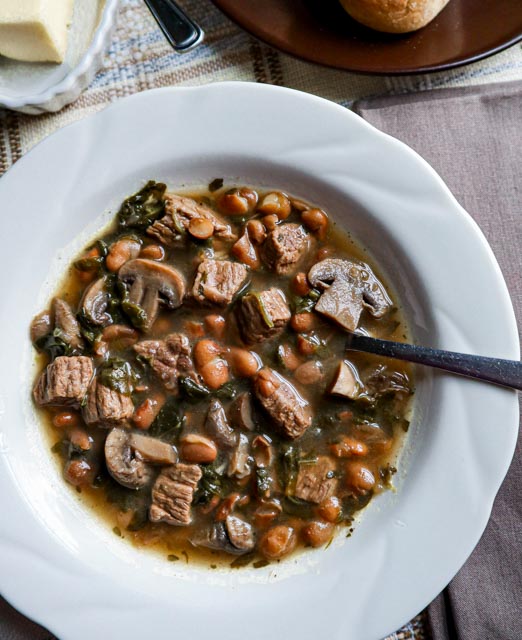with Mushrooms and Spinach
Beef and Beans Stew: a full low carb meal in a bowl
This stew has everything going for it. With beef, pinto beans, mushrooms and spinach our beef and beans stew is packed with protein, fiber and plenty of vitamins and minerals. And it’s a great meal for those wanting to cut down on unhealthy carbohydrates. Dried beans have carbs, but they are healthy ones.
All that good stuff also makes this meal hearty and satisfying. No one will walk away from the dinner table hungry when you serve this for dinner.
A staple world wide
Dried beans (legumes) have been a staple in cooking for eons all over the world . Why? They are a powerhouse nutritionally and are very inexpensive. They can be stored for extended periods of time without refrigeration and come in countless varieties. There are limitless ways to incorporate dried beans into your recipes. You just can’t go wrong when you include beans in your dinner menu.
Dried beans are the most economical way to add beans to your diet, but canned beans are very nutritional too if you are whipping up a quick weekday meal.
Beans are back
Using dried beans as part of the main course has become more mainstream these days.
During the first half century of my life the most popular bean dish I saw being served was baked beans from a can. Those were the days of hot dogs and beans on Saturday night. I guess it goes without saying that I am from a meat and potatoes, milk and butter family. Eating habits and cultural background are one in the same. I wrote a post on the history of my meat and potatoes family’s culinary background in Cooking with Wine.
In the last 15 or 20 years things have changed dramatically for the humble dried bean. Bean dishes are far more accepted in everyday American cooking. The movement toward healthier eating and the need of many to stretch their meal budget has helped bring main course bean dishes back to our tables. Dried beans top the charts on both counts.
Our bean dishes are very popular. We have an easy meatless soup LENTILS WITH PASTA and an easy version of a classic SPLIT PEA SOUP.
Putting beef in it’s place
Beef comes first in the name of this recipe, but not in the place of importance to the dish. Many cultures use meat to help flavor a recipe, rather than have it as a featured ingredient. If you want to use less beef, by all means do so.
While we have used a hearty amount of beef, we could have easily gotten the flavor we wanted with a lot less of it.
Get more beef flavor from less beef
Make a Fond
A fond is the brown crust that builds up at the bottom of a pan as you sauté protein ingredients. Building a fond to enhance flavor is a classic technique in cooking.
It sound fancy, but that is far from the truth and we are going to show you just how easy it is.
Using dried beans
Dried beans take quite a bit of time to cook, especially if you have not soaked them in advance. We try to keep things simple and avoid a pre-soak if we can.
In this recipe we are going to use an inexpensive cut of beef and let it slowly cook to tenderize it. Our beans will be fully cooked in the time it takes to cook the beef so we are just going to rinse them off and add them to our stockpot with the other ingredients.
Nothing says comfy cozy better than a simmering pot
I love the home sweet home feeling I get from a pot simmering on the stove with all it’s yummy aroma wafting in the air. So cooking a pot of stew or soup that takes almost no time to put together but can simmer for hours it’s a win, win situation for me.
Here’s what YOU WILL NEED:
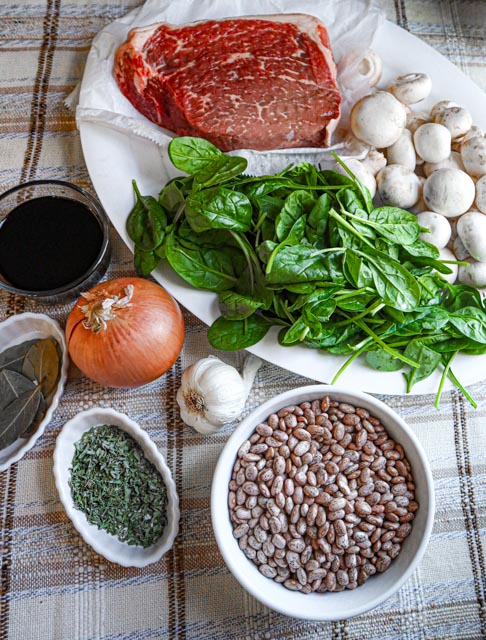
| 2 pounds of inexpensive beef cut in cubes such as top or bottom of the round roasts or London broil or chuck steaks |
| 1 pound white mushrooms (or another mushroom you prefer) |
| 1 pound dried pinto beans |
| 1 large yellow onion |
| 5 cloves fresh garlic |
| 2 teaspoons dried thyme & 2 teaspoons dried oregano or one heaping tablespoon Italian mixed herbs |
| 2 teaspoons salt |
| 3 or 4 good sized bay leaves (see note about using bay leaves) |
| fresh spinach (one 9 ounce plastic clamshell box works well) |
| 12 cups of water |
| 1/4 cup soy sauce for a slurry |
| You will also need 1/4 cup olive oil and 3 tablespoons corn starch |
About the ingredients
Beef
When shopping to make this batch of beef and beans, I found a bottom of the round roast on sale and cut it into pieces myself. Often times the stew beef that has been pre-cut is not in the size I want. Plus pre-cut stew beef is usually vastly overpriced.
Cutting my sale priced roast into bite sized pieces was a cinch. I cut a few slices about an inch thick and then cut the slices into cubes. By cutting it myself I can remove any fat or gristle and get uniform sized pieces. Saving money on a higher quality ingredient is the way to go in my book.
The tougher cuts of beef are best for soups and stews. Chuck, bottom of the round, even top of the round will work. Stay away from more tender cuts like eye of the round or sirloin. The more tender cuts lose flavor with extensive cook times.
Beans
In this recipe we are using pinto beans, but you can use any dried bean that you like. We are not soaking our beans in advance. Since this recipe is going to be simmered slowly on the stove, after rinsing the beans and checking to see if any foreign materials have found their way into the bag while processing, we are adding them without a presoak.
Eliminating the need to presoak means I don’t have to have planned too far ahead! For me that’s a good thing.
Herbs
We are using dried oregano and thyme for our stew (my own homegrown). Both are really good in beef dishes. Or instead you can use a heaping tablespoon of bottled mixed Italian herbs. That’s great in this recipe also.
Just an FYI: 3 Teaspoons are equal to 1 Tablespoon, so a heaping Tablespoon of mixed Italian herbs is about the same as the 2 teaspoons of thyme plus 2 teaspoons of oregano.
When making a long cooking recipe you should use dried herbs. If you want to use fresh herbs hold off adding them until the last 10 minutes or less of the cooking time. Fresh herbs lose a lot of flavor when cooked.
Want to know more about when and why you should consider using fresh vs dried herbs? Check out our post Cooking with Herb.
Bay leaves
Bay leaves come in all sizes. My bay leaves were on the smaller side so I used 4 in this batch. If they are large, only use a couple. You don’t need to be exact.
When you are buying bay leaves look into the bottle or bag to see if a bunch of leaves are already in pieces. A bunch of broken pieces are almost useless to you. Bay leaves do not get soft when they are cooked. They need to be removed before serving, they can cause choking. Small chips of leaves are going to be almost impossible to find and remove unless you are going to strain the broth before serving. Straining is not an option in this recipe.
Stick with using whole bay leaves or very large pieces in a recipe that you are not going to strain before serving, such as this one. Count them as you put them in so you know how many you are looking for when it comes time to scooping them out.
Onion
We are using a yellow onion. They are a stronger flavor than most other onions. In general yellow onions can hold up to longer cook times and the flavor is not as easily lost when cooked with lot of other competing flavors.
But the best onion to use when you are cooking this recipe is the one you have. Any onion can be used. Be aware that sometimes if you use a red onion in a soup or stew you may see a blueish tinge to the broth. It’s not a taste thing, its a chemical reaction that has no other effect on food value or flavor.
Spinach
We are using spinach in our stew. If you have another leafy green that you like to use in soups and stews, go for it. Or, if you don’t want to incorporate a leafy vegetable that’s fine. It’s a personal preference ingredient. We are adding our baby leaf spinach near the end of the cooking time because it takes so little time to cook. If you are cooking with a sturdier leafy green, it may need more time to cook.
You don’t need to be fussy about how much spinach you are adding. It melts down when cooked. I used one of the regular sized (9 ounce) clear hard plastic containers of spinach. They are commonly referred to as clamshell containers. The top is attached to the bottom on one side and and the container opens from the middle. I am guessing that is where the name comes from.
If I am buying packaged greens, I prefer buying the hard plastic containers to plastic bags. The greens stay fresher, longer.
Mushrooms
We are using white button mushrooms in our stew. You can use any type of mushroom if you want.
I start with whole mushrooms for this recipe. You can use pre-sliced mushrooms if you want. Mushrooms shrink quite a bit when cooked and I like larger chunks in this stew. That’s why I prefer using whole mushrooms and cutting them up myself. Plus, I have found whole mushrooms will last longer in the refrigerator than pre-sliced.
Slurry
We are going to make a slurry to add just before the stew is done. Slurry is one of those fancy cooking terms that can intimidate someone new to cooking. The term is fancy but the purpose and the process isn’t. You use a slurry as a thickening agent for soups, stews and gravies.
The word slurry can apply to other things, but I have to say, in my long life, cooking is the only time it has applied.
Our slurry will thicken our broth into a thin gravy. It is made with soy sauce and cornstarch. The soy sauce will add a deep salty flavor to the stew. The cornstarch in the slurry does the thickening. If you would prefer serving this recipe as a soup rather than a stew, omit the cornstarch but definitely add the soy sauce.
A note about Salt
This recipe calls for 2 teaspoons of salt. If you are used to making soups and stews you may question why so little salt is added to such a big batch of stew. We are being conservative in how much salt we are adding during cooking because we are adding quite a bit of soy sauce with the slurry at the end. As you may know, soy sauce is a very salty ingredient.
After you have added the soy sauce to the stew, you can taste test for salt. It is likely you will want to add more, but you are much better off safe than sorry. Too much salt ruins a dish and there is no getting it out once it’s in there!
When you are deciding how much salt you should use in a recipe, you should consider how much salt there is in other ingredients you are adding. If you are adding canned goods, they are usually pretty heavily salted. Some seasonings have salt in them. And using salted butter can add quite a bit of salt to a recipe.
This is WHAT TO DO:
Prepare the ingredients
Cutting and trimming the beef
I have some fat on my roast which I trimmed off and cut into slices. We are going to use those slices of fat to make a fond. A fond is the fancy name for the brown bits that stick to the bottom of the pan when you sauté meat. The fond is a flavor goldmine. If you are using pre-cut chunks of beef and don’t have any strips of fat, just cut up 3 or pieces of the beef chunks and use those to create the fond.
If you have chosen to buy a roast or thick steak cut it into large bite sized cubes. Cut inch wide slices and then cut the slices into cubes. The meat is going to shrink during cooking, so larger chunks of beef will allow for shrinkage and leave you with pretty good sized pieces in the stew. I cut mine in one inch cubes.
Cut the rest of the ingredients if necessary
Chop the onion, garlic and if you bought whole mushrooms, cut them up too.
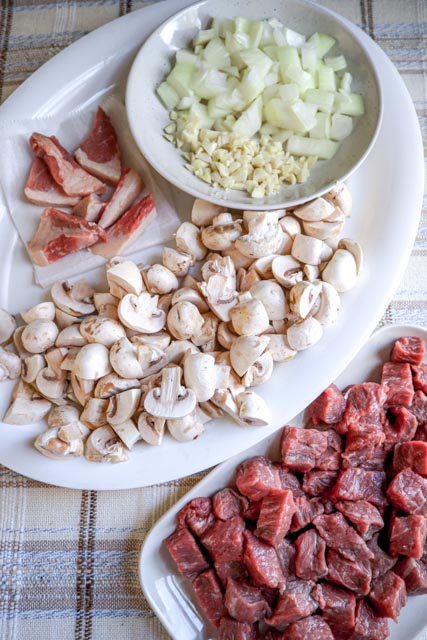
If you have chosen to buy a roast cut it into large bite sized cubes. The meat is going to shrink during cooking, so 1 inch pieces of beef will allow for shrinkage and leave you with good sized pieces in the stew.
Slice the fat that was trimmed from the roast to make the fond. No fat? Cut up 3 or 4 pieces of pre-cut beef to make the fond.
If you bought whole mushrooms, chop them in bite sized pieces keeping in mind that like the beef, the mushrooms are going to shrink quite a bit too.
Rough chop the onion and garlic.
We are ready to start cooking
Maximizing the beef flavor
By sautéing the fat I trimmed off the roast I will be “rendering” beef fat as a base of my stew. Basically, rendering (melting meat fat) will give us more flavor. Beef is not the only meat used to render for flavor. Rendered bacon fat is often used to add flavor a dish. And many Italian gravies start with rendered salt pork.
But, the rendered meat fat is not the star of the show when it comes to adding flavor to our beef and beans stew. Rendering the beef fat is also going to create a light crust of beef on the bottom of the pan. The brown crust that forms on the bottom of the pan is referred to as the fond. The fond is a powerhouse of flavor.
If you purchased stew beef that was already cut, you can create a fond using 3 or 4 pieces in the pan instead of sliced fat we are using. In either case, we are going to remove them after they have browned.
Let’s make that fond
Use a large pot, commonly called a Dutch oven, a soup pot or a stockpot.
Warm the pan up on medium high heat. Add 1/4 cup of olive oil to the pan and let the oil heat up. Then put the beef fat (or small pieces of stew beef) in the pan and let it brown. Stay at the stove and move the beef around in the pan. It’s okay if it sticks but you want to keep it from burning. There may be flecks of black before you are done, and that’s okay. But most of the fond should be brown.
Here’s what that looks like
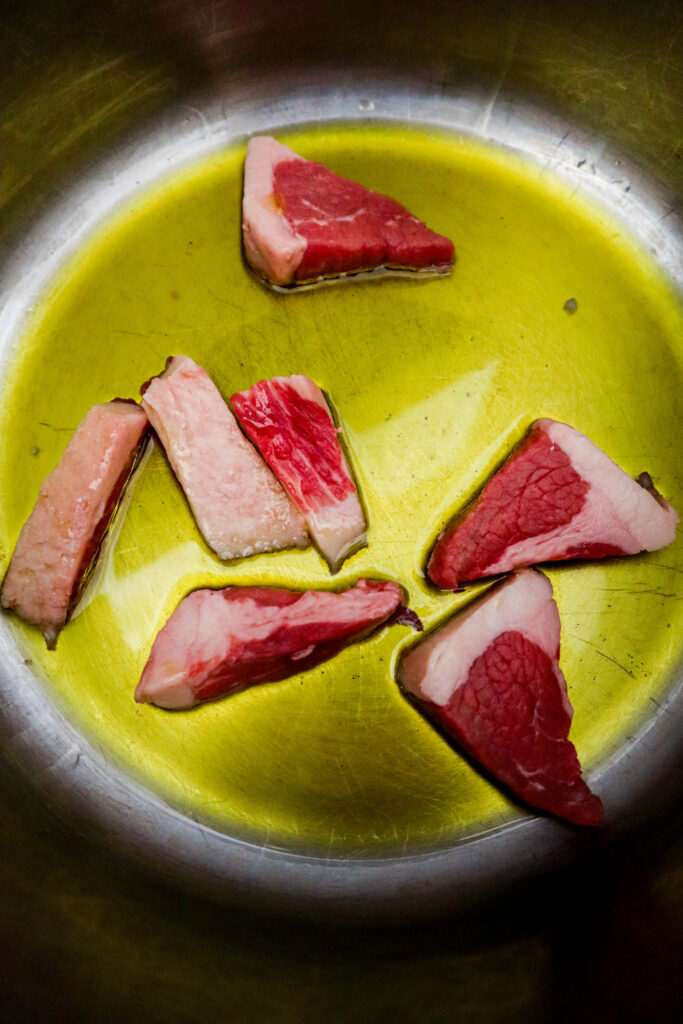
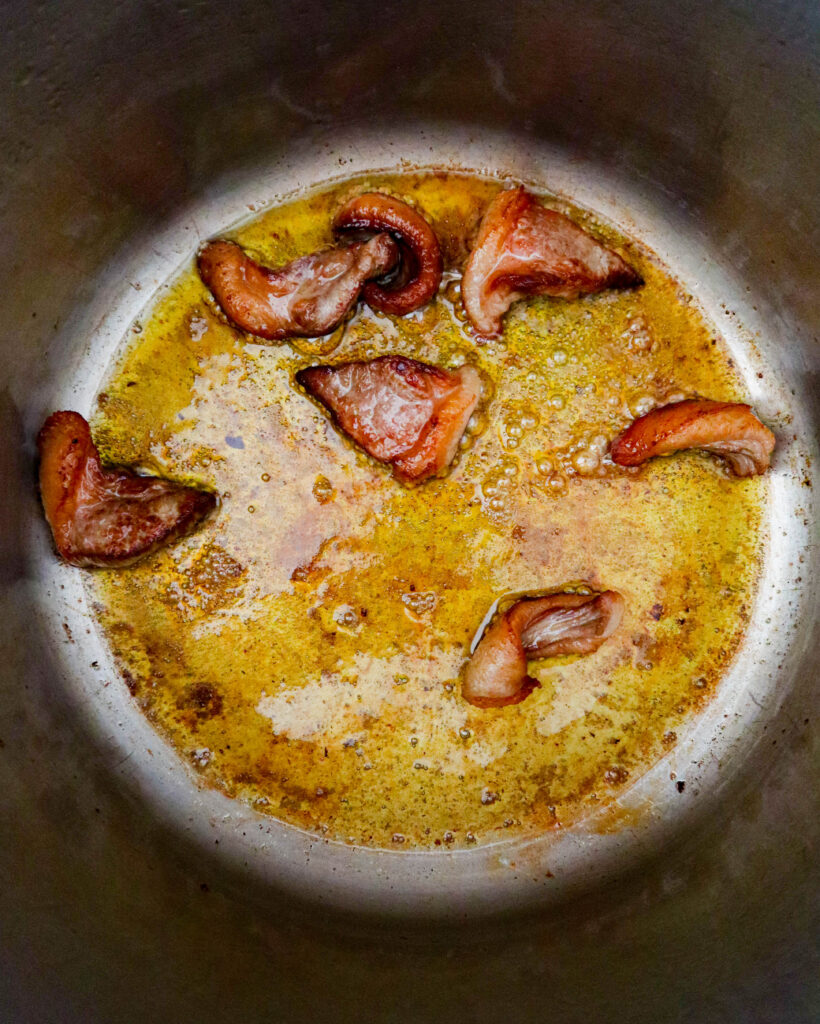
Remove the fat from the pan
After the fat has browned, it has done it’s job. Remove the pieces of fat (or pieces of stew beef) from the pan before the next step.
Sauté the chopped onion and garlic
Staying on medium high heat, add the chopped onion and garlic to the pan with the fond and sauté until the onion is translucent. Do not brown the garlic or onion.

Sauté the chopped onion and garlic until the onion is getting translucent. Don’t brown the garlic or the onions.
The brown at the bottom of the pan is the fond that is continuing to cook.
Add herbs
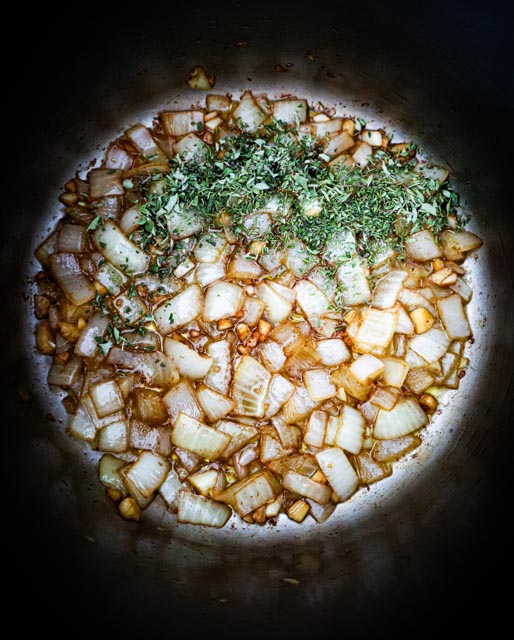
Mix the dried herbs to the sautéed onions and garlic. You are not cooking them, just mixing them in to wake up the flavors and get them incorporated.
Deglazing the fond
I know for many would be cooks, it is words like fond and deglaze that stops them in their tracks when it comes to cooking their own dinner at home. Hopefully the explanation I give for the process gives you all the technical information you need to perform the function. But here is why I use a words like fond and deglaze. If I can introduce you to the more formal culinary term, when you see it in another recipe, you may not be caught off guard and quit right there.
Once you have a fond (the brown coating on the bottom of the pan) you need to incorporate the fond into the recipe. You do that by deglazing. Deglazing is the term used for dissolving the fond into liquid to capture the flavor and disperse it into the dish you are making. You can use any liquid that will complement your recipe to deglaze. In our case, we are just going to use a little of the water we are going to use in the stew.
After you have mixed the herbs into the onion and garlic, add a cup or so of water (part of the 12 cups you are adding) and stir it in. A wooden spoon works best for this step. As you are stirring the water in, scrape at the crust on the bottom of the pan (fond) to dissolve it into the water. It won’t take long. When the brown crust is dissolved, continue with the next step.
Add the water, mushrooms, beef, beans and bay leaf
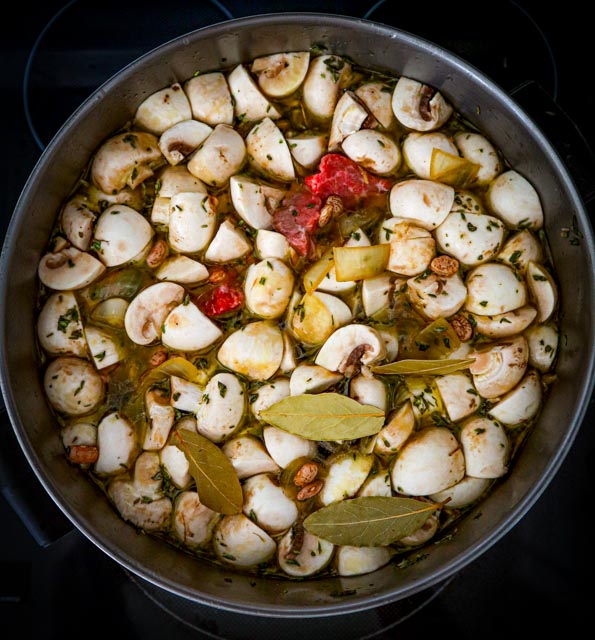
Add the remaining 11 cups of water, beef, beans, mushrooms, salt and bay leaf to the pan.
Do not add the spinach or the slurry yet. We will be adding them at the end.
Bring to a boil, turn down to a simmer and cover
Bring the stew to a boil and then turn the heat down to simmer. Cover the pan and simmer for about 2 hours. Your stew is done when the beef and beans are fork tender.
Making a slurry
While your stew is simmering make a slurry.
A slurry is used to thicken gravies and stews. We are going to add our slurry at the end of the cook time and mix it into the cooked stew ingredients.
A slurry can be made using either flour or corn starch as a thickening agent. We are using corn starch for this recipe. As a general rule, you need less corn starch than you do flour to get the desired consistency/ viscosity.
Whether you are using flour or corn starch in your slurry, you need to emulsify it before adding it to your stew. You do this to prevent lumps. To make a slurry you add a cold or cool liquid to a jar, then add the corn starch (or flour) and shake it up to emulsify it. Once shaken if not used right away the corn starch may settle to the bottom. No harm done, just shake it up again before adding.
If you don’t have a covered jar or another covered container available you can stir the flour or cornstarch into your cold liquid. It just takes a little longer. Make sure you get the ingredients fully emulsified and you haven’t got a layer of dry flour on the bottom.
We are using soy sauce as our liquid and corn starch as our thickening agent.
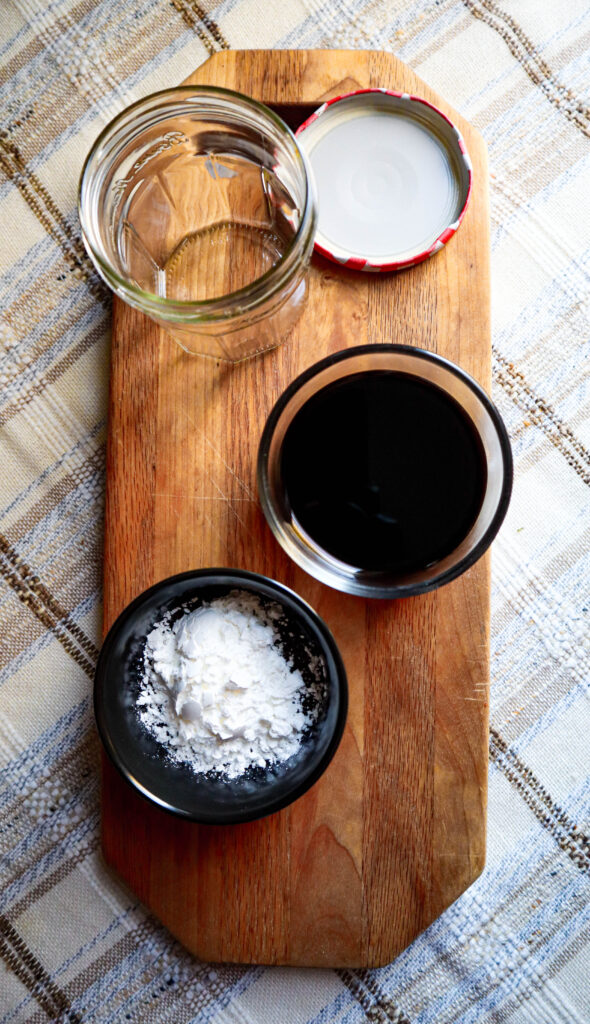
Add 2 tablespoons corn starch to 1/4 cup of cold soy sauce. Shake until it is fully emulsified (combined) into a liquid.
When to add the slurry and spinach
When your ingredients are cooked, it is time to add the slurry and the spinach.
Turn up the heat to medium high and bring the stew to a boil. This will thicken the slurry and cook the spinach.
Add the slurry slowly and fully incorporate it into the stew. Then add your spinach. I use the small leaf baby spinach which only takes about 10 minutes to cook. Other greens may take longer.
Continue to stir the stew as it is thickening and the spinach is cooking. Make sure the slurry doesn’t sink to the bottom and stay there.
The spinach is going to shrink up quickly when added to the hot stew. When the spinach is done and your gravy has thickened up, your stew is ready to serve.

Once your spinach is done and your gravy has thickened up a bit your stew is ready to serve.
It’s is delicious, full of hearty, healthy, low carb ingredients and so satisfying.
Serve
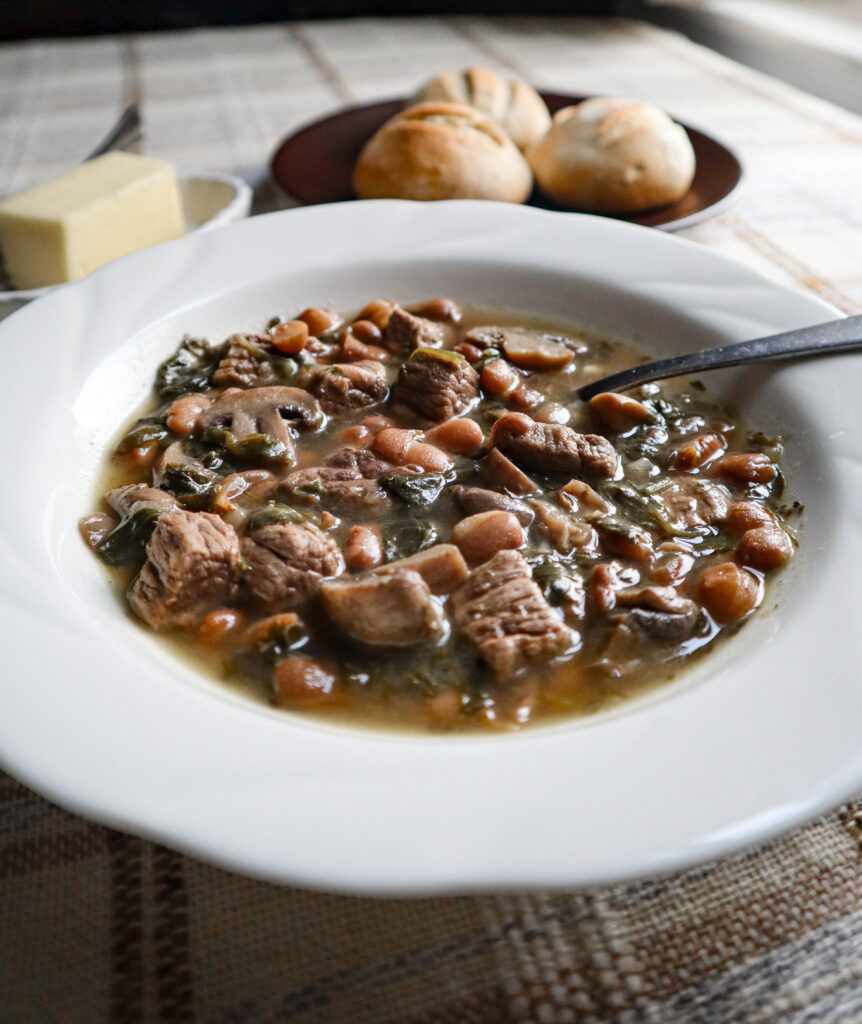
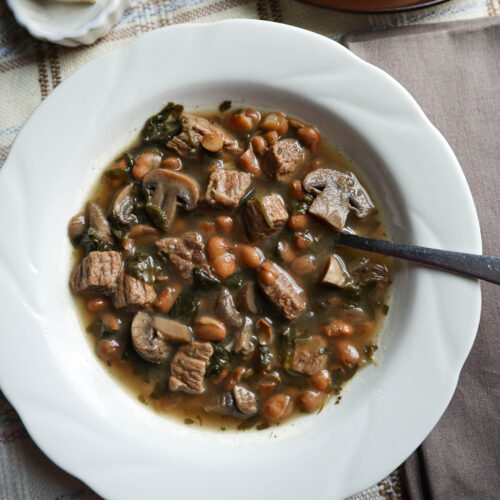
BEEF AND BEANS STEW
Ingredients
- 2 pounds stew beef you can cut your own from a roast
- ¼ cup olive oil
- 5 cloves garlic
- 1 large yellow onion
- 2 teaspoons dried oregano
- 2 teaspoons dried thyme
- OR you can substitute the thyme and oregano with a heaping tablespoon of Italian mixed herb seasoning.
- 1 pound dried pinto beans
- 1 pound mushrooms 1 pound =16 ounces
- 2 teaspoons salt
- 3 bay leaves
- 12 cups water
- 9 ounces baby spinach
- ¼ cup soy sauce
- 2 tablespoons corn starch
Instructions
Prepare Ingredients
- If using a beef roast or a thick steak instead of pre-cut beef, cut into 1 inch square pieces. Slice any excess fat to make a fond. (Buying the roast or steak on sale can safe a fortune compared to pre-cut stew beef.)
Cooking Instructions
- In a large stockpot or Dutch oven, brown a few slices of beef fat or stew beef in 1/4 cup olive oil on medium high heat. You want to build a brown coating on the bottom of the pan that will enhance the flavor. That coating is called the fond. Stir often, you don't want the meat to burn.
- Remove meat/fat from the oil and add the garlic and yellow onion. Sauté until onion is translucent.
- Add dried herbs to the onion and garlic and mix in.
- Add 1 cup of water to the pan to deglaze the fond. Basically deglazing means to dissolve the brown crust into the water. This will ensure you are getting all the flavor from the fond and it will incorporate easily.
- Add beef, mushrooms, dried beans, bay leaves, salt and the remaining 11 cups of water to the pan. Do not add the spinach yet.
- Bring water to a boil and then turn down to simmer and cover. Simmer, covered for 2 to 2½ hours until beans and beef are tender.
Make a slurry
- While the stew is simmering make a slurry. Add ¼ cup cold or room temperature soy sauce to a jar with a cover, add 2 tablespoons cornstarch, cover and shake until the cornstarch is emulsified (fully combined) into the soy sauce.
Finish the stew after the beef and beans are done
- Bring the stew back up to a boil, add the slurry and the spinach and stir for 10 minutes until the spinach is cooked and the slurry has thickened the gravy.

